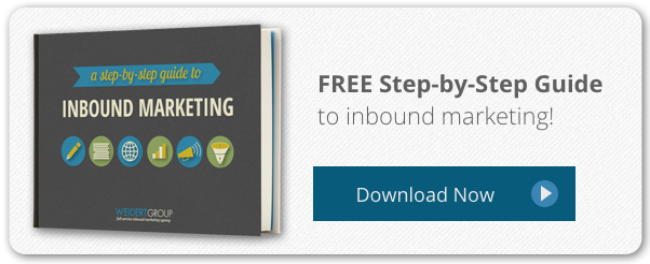 The best thing about inbound marketing is that its process is simple: each step is a goal for moving customers closer to a purchase.
The best thing about inbound marketing is that its process is simple: each step is a goal for moving customers closer to a purchase.
Attract. Convert. Nurture. Close. (Yeah, I know that it's a variation on what HubSpot says, but at Weidert Group we never downplay the impact of nurture—and we still manage to delight.)
You begin by attracting prospects to your website. You convert the visitors by encouraging them to submit their contact information.
You use this information to nurture the contacts toward more interest. And, eventually, the most interested leads become customers when your sales team closes their purchase.
Overall, it’s just four steps—super easy to understand. The hard part comes when you’re trying to make each step work effectively. For this, inbound marketing requires content—a lot of content. High-quality content is inbound marketing’s heavy duty diesel.
It’s the knowledge that makes visitors attracted to your site. It’s the motivation for prospects to submit their contact information. And ultimately, it’s the substance behind lead nurturing that provides the answers leads need to close into customers.
Knowledge. Motivation. Substance. Answers.
Unlike the traditional four-step view of inbound marketing, which orients marketers toward the sale, these four words tell us about the messaging of inbound marketing’s underlying content. They describe what inbound marketing content is saying and how a company is being positioned.
For instance, when companies aim to attract prospects, knowledge-infused content attracts visitors because most prospects want useful, helpful information from knowledgeable experts. That’s a no-brainer. If you’re a marketer with a job, then there’s probably no question that you understand this point.
However, many of us aren’t so used to only thinking about conversion in the context of lead generation. Between attracting large audiences and moving them to the sale, we forget that converting prospects into leads requires an important layer of content that’s all about creating motivation.
Motivating Visitors Toward a High Conversion Rate
Specifically, think about how calls-to-action position a company for a certain kind of motivation. What’s the best positioning for your company? Should CTA content motivate prospects to:
- “Download a guide”
- “Get a free quote”
- “Schedule a Consultation”
- “Learn more”
- “Explore Top 10 Tips”
It’s not all about picking an impactful verb. Consider what these various CTA messages are actually motivating customers to do within the full context of a sale. I’d argue that the CTA is actually the first step in establishing a relationship with your prospects.
For instance, let’s consider the difference between “Download our free guide: The Inbound Marketing Guide for Manufacturers” and “Explore Inbound Marketing Strategy the Way Top Manufacturers Do It.”

While the second sentence emphasizes strategy and stresses that successful manufacturers use inbound marketing, the first offer makes clear that the prospect will receive a free guide they actually can keep. It’s clearly saying that we want visitors to walk away with free guidance, no matter what.
Both sentences tell the prospect that this piece is specifically for manufacturers. While the second sentence may be flashier and slightly more descriptive, the first makes it clear to the user that they’re going to get immediate value, regardless of whether they become a customer.
By emphasizing the value to manufacturers, we’re deliberately clarifying our position that a key emphasis within our business is to sell to manufacturers. I also think the first sentence is a stronger approach, but the language in the second sentence could be used to firm up the offer in the landing page for the CTA.
Either way—the position is clear: our services can be valuable to manufacturers and we have the strategy to prove it. That’s a big motivation for a manufacturing visitor to explore more.
Positioning Your Products or Services
Of course, not all conversions are as top-of-the-funnel as a guide or ebook. Other CTAs aim to move a ready prospect further down the funnel toward a sale. For example, if a lead visits your site looking to buy, you need a ready and open CTA to attract them toward getting sales-ready information.
In these situations, the content included in a CTA is as vital to your positioning as your company description. Are you trying to portray your offer as a product or a service? Are you motivating prospects to buy or to invest? Use or Engage?
Plenty of companies have clear positioning for these questions, and you can see it in their CTAs. Take, for instance, the insurance industry.
Every home page—whether small or large—has an opportunity for ready buyers to get immediate sales information. What these CTAs say, though, are pretty different.
Esurance.com, for instance, has only one, large CTA on its page for prospective customers. It says: “get your fast, free quote now.” From a messaging standpoint, this CTA is oriented to sell insurance as a quick and easy product. You can buy online, get coverage fast, and worry about claims later.

In contrast to this approach to insurance CTAs, other companies take the approach of positioning quotes as service. For instance, one of Weidert Group’s clients, Integrity Insurance takes the approach of using “Find an Agent” as a CTA in addition to helpful guides that move clients further down the funnel.

Here, Integrity’s messaging positions the company as fundamentally different from Esurance or other large brokers. The CTA emphasizes service, a personal relationship, and a one-to-one interaction. Then, CTAs that showcase helpful guides serve as powerful encouragement for prospects who want to learn what the service will be like.
Regardless of the situation, CTAs tell the customer a lot about a company’s position and what they might be able to expect. In order for conversion to happen, you want to make sure the messaging aligns directly with what you actually offer. Providing honest, useful information is a hallmark of a strong inbound marketing approach, and the same should apply for the detail messaging of a conversion offer.
If you’re interested in more information in creating a website that generates leads through knowledgeable, motivating messages, read our all-encompassing guide: the Step-by-Step Guide to Inbound Marketing.
This post originally appeared on the Weidert Group's Whole Brain Marketing Blog. The Weidert Group is a HubSpot Partner Agency located in Appleton, WI.

